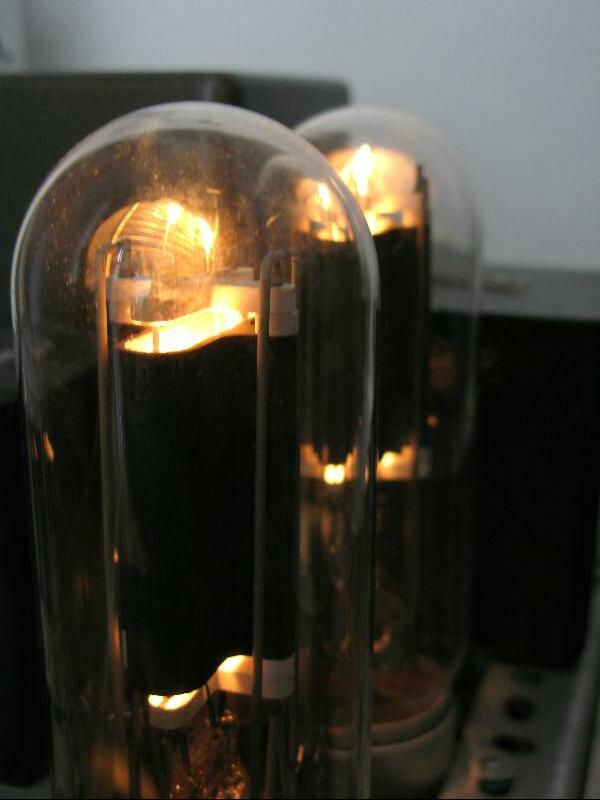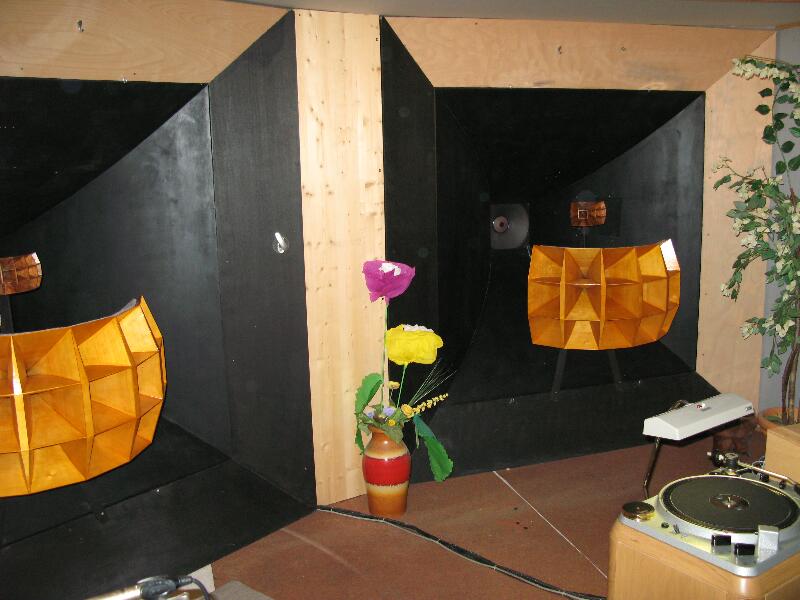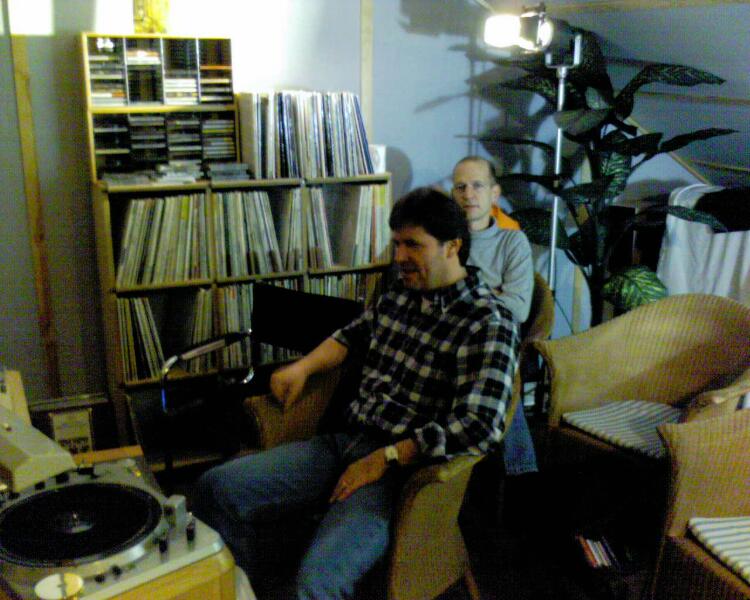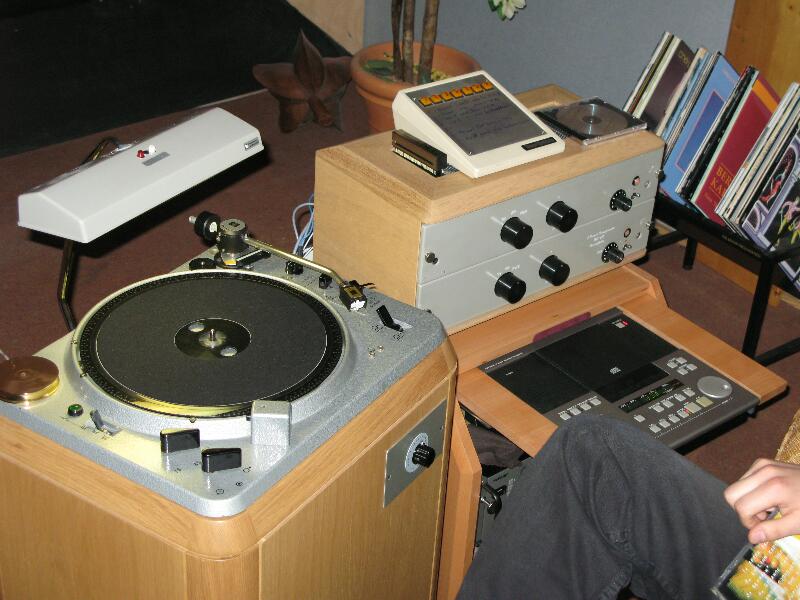

![]()
1st "Schall & Rauch" - Festival in Munich
Part
2

After
a good night of sleep and a breakfast at our hotel, we began Day Two
of our listening sessions at "Schall & Rauch."
Unfortunately, this was also the day we had to leave and head back to Vienna.
The day began with a visit to Ralph Gibbemeyer's house. His dedicated music room is like Hartmut's - located in the cellar of the house he and his wife rent - another fortunate guy with a dedicated music and work space room in the cellar. (I've heard some rumors, though that we audio fanatics often choose the cellar room because our "beautiful halves" don't like to share our systems in the living room...).
Ralph is definitely a lucky man, because he can choose from various analog sources, if he's in the mood for it. During our 2.5-hour visit, which was definitely too short, a Scheu platter on a steel base with Maxon motor, Immedia arm and Ortofon MC 5000 was the analog front end. There was also a Morsiani turntable with granite base, Morsiani motor and electronic speed control, but unfortunately no time to have a listen :-(. The preamp was a modified Conrad Johnson PV10A and the power amp an SE 211 with 46-driver stage. The loudspeaker system consisted of homebrew three-way speakers with two Focal bass drivers, a Thiel 173-90 midrange driver and a Thiel 30mm ceramic tweeter per cabinet.
The
surprise for us was that Ralph had planned to perform an output
transformer shoot out with three high-class output transformers
(Thanks for doing all the soldering on the fly!) The three contenders
were: JRE-Electronics 308B-Spezial 13kOhm primary impedance, Lundahl
LL1691-70 9.5 kOhm primary impedance and the famous (and expensive)
Tango X-10S 10kOhm primary impedance. The shoot out was great
fun and there was no clear winner for me. Although the Tango was the
most charming and musical-sounding one to my ears, the JRE - a German
brand named Ritter Electronic Systems - had better bass definition
and reached a bit deeper into the lower register, lacking only a bit
of treble resolution in comparison. The Lundahl performed also
extremely well, with tight bass definition and great resolution; it
seemed to be the best all-rounder in this shoot out. All three OPTs
were top-class performers though, and the good news is that two of
them (Ritter and Lundahl) are more than affordable choices.

Ralph's SE 211 power amp with 46 driverstage. In the front you can see the 3 pairs of output transformers we compared during the session
Photo courtesy of Bernd Uecker
|
One
of Ralph's current main speakers (on the left you get a glimpse of the |
Part of Ralph's system, to the right the TT collection and his phono stage below. This photo was shot with a mobile phone's built in camera. Apologies for the poorer quality... Photo courtesy of Michael Joncic |
Our next stop was the home of Dietmar Hampel, about 30 km outside of Munich. We arrived at about one p.m. and Dietmar's wife surprised us with a spicy pumpkin soup with jumbo prawns - extremely delicious. This was definitely a highlight and hard to top by an audio performance, I thought, not knowing what I would experience 15 minutes later in Dietmar's music room.
His
listening studio is in the attic of their house - an awesome place
and horn-speaker lover's dream. Part of his attic studio is used to
house his 2x2m bass horns (Philips cinema horns), replicas of the
famous Altec 1505 multicell midrange horns in wood (made by CH
Audio Design
in the US, contact: mail"at"chaudioroom.com) and 15 cell
treble horns (made by Dietmar). The drivers used are Altec 515B for
bass, Philips 5502 for midrange and JBL 075 (with phase plug JBL
2404H) for the treble section. To ensure time alignment for the three
horn sections per side, he uses an active digital crossover, a Sony
SRP F700 driven by various homebrew tube power amps (the bass amps
are EL34 push pull, the remaining tube amps work in SE mode,
consisting of an EL84 amp in triode mode for the mids and a 300B amp
for the tweeter section). Pre-amplification and phono stage are also
tube based, the analog source is an EMT930 studio turntable with EMT
arm and Van den Hul Grasshopper cartridge, and the digital source is
a Studer A730 cd player. Absorbing material is used throughout the
room (walls and ceiling) to preserve studio-like room acoustics.
Before we had a listen, Dietmar gave a short and highly informative
presentation about his system. My writing above can't fully describe
this awesome system so here are some photo impressions:

Cool
speakers, aren't they?
Photo
courtesy of Bernd Uecker
|
The source components plus pre amp Photo courtesy of Bernd Uecker |
Nearfield view of mids and treble multicell horns Photo courtesy of Bernd Uecker |
|
Dietmar presenting his system Photo courtesy of Gunter Marquart |
Part 2 of Dietmar's presentation Photo courtesy of Bernd Uecker |
As
you can see from the photos, Dietmar prefers to listen to music in a
close-up range (in the center of the first row, so to say) and man, I
can tell you it was an awesome experience for me. Direct, dynamic and
the performers seemed so close and real that you had the feeling you
were in the middle of the venue. It felt like listening to a huge
pair of headphones. Highly impressive and enjoyable. I definitely
could have stayed a lot longer in first row ;-).


|
In the middle of the music ... Photo courtesy of Michael Joncic |
OK, I had fun as you can see and didn't want to give away my center space! Photo courtesy of Michael Joncic |
By
then, we had only a bit of time left and decided to stop by Manfred
Huber's place to say hello before heading home to Vienna. Manfred is
also a friend of Josef's and his tube amp designs were always a
highlight for me at the European Triode Festival gatherings in the
previous years. For a real listening session - as scheduled for the
other Schall & Rauch participants - there was unfortunately no
time, but we had a quick blind-listening test to compare two
amplifiers Manfred had recently built, only one of the two being an
SE tube amp. To make a long story short, our vote for amplifier A as
the more musical SE tube amp turned out to be a vote for class D
monos using the new Hypex modules UcD180HG plus Hypex power
supply-modules (the other amp was Manfred's DIY SE 300B amp, by the
way). Holy crap, class D amps can do SE magic tricks? That's
definitely something to check out more carefully in the future.

Manfred's
system after the power amps were revealed. In the rack at the bottom
you can see his
SE
300B amp and beside the pair of Hypex class D monos
Photo courtesy of Bernd Uecker
After
this "musical culture clash" - in a positive way, of
course - Manfred's wife Monika surprised us with wonderful homemade
desserts, one of which was an extremely delicious poppy-seed cake. I
then had an idea why all the other Schall & Rauch audio friends
were so excited to be invited for dinner at Manfred's and Monika's place&ldots;
We had tremendous fun at the Schall & Rauch festival. Many thanks to our Munich friends for setting this event up. Great job!
We headed to Vienna with a lot of new ideas in our minds. There will be a similar event in 2008 in Vienna, I'm sure.
Musically yours,
Norbert
PS: Here are some photos of Peter Zöllner's system, which we Austrians unfortunately couldn't audition. Peter has unique choices with respect to the cabinets he uses for his home brew amps:

Photo
courtesy of Gunter Marquart
|
A musical 8 channel multiplexer... |
|
Photos courtesy of Bernd Uecker
Thomas Mayer informed me about two changes he introduced to his superb speaker system after "Schall & Rauch". Instead of the pair of Altec 515B for the lower midrange of each channel he now uses a pair of 12" Altec 414A for each channel. Furthermore, he changed the TAD RPT7 tweeter to a Goto tweeter. According to Thomas' these changes improved the sound quite a lot. The midrange is now more uncolored with increased naturalness, the treble section has gained resolution and clarity.
Munich seems to be one more time worth a journey...
©The
Audio Eagle 2005-2014 •
All Rights Reserved • Disclaimer

















